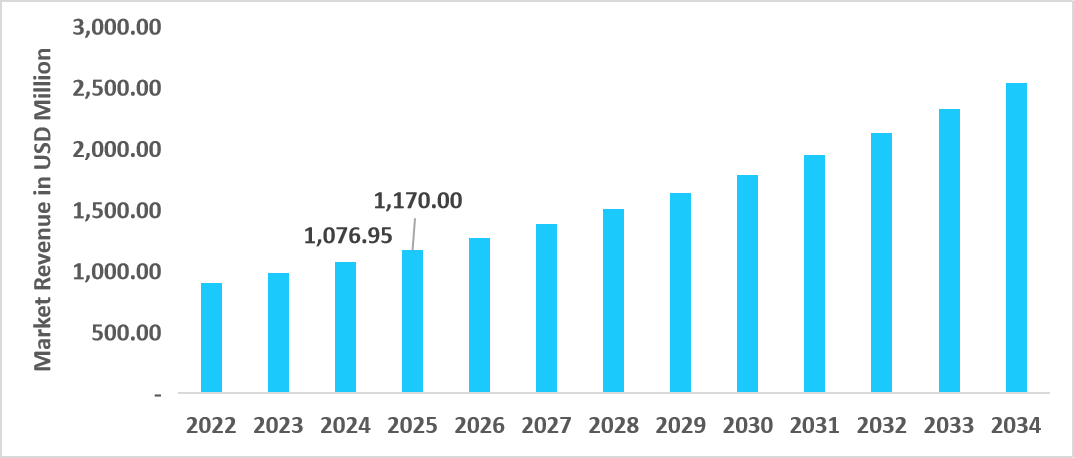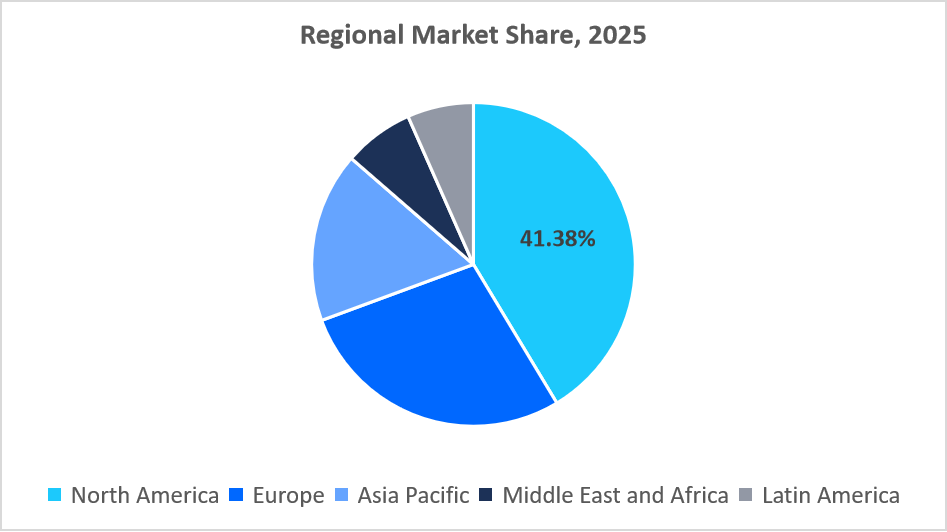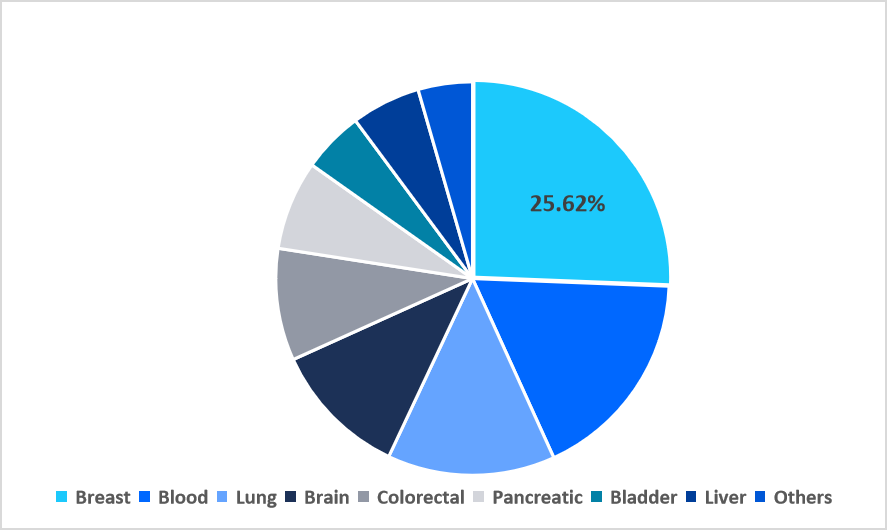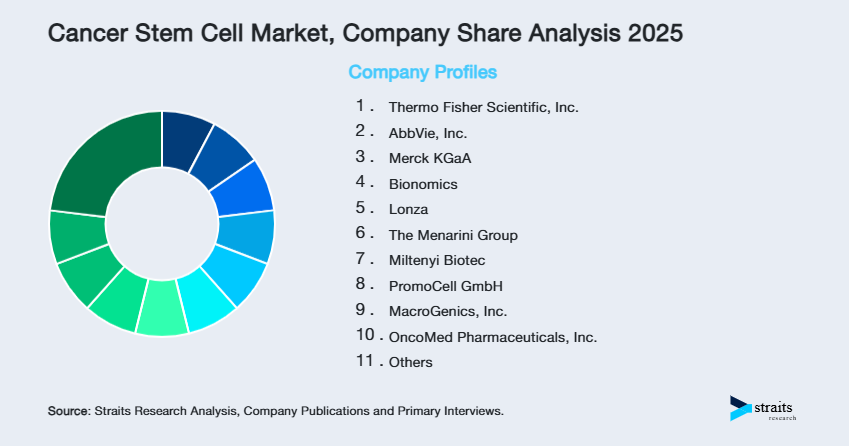Cancer Stem Cell Market Overview
The global cancer stem cell market size is valued at USD 3.03 billion in 2025 and is estimated to reach USD 6.58 billion by 2034, growing at a CAGR of 9.03% during the forecast period. The substantial growth of the global market is stimulated by the growing use of personalized medicine, where CSC therapies are tailored to individual genetic profiles.
Key Market Trends & Insights
- North America dominated the global market with a market share of 41.38% in 2025.
- The Asia Pacific region is projected to grow at the fastest pace, with a CAGR of 11.52% from 2026 to 2034.
- By mode of action, the stem cell-based cancer therapy segment is estimated to grow at a CAGR of 9.11% during the forecast period.
- Based on cancer type, the breast cancer segment dominated the market with a revenue share of 25.62% in 2025.
- The U.S. dominates the CSC market, valued at USD 1.07 billion in 2024 and reaching USD 1.17 billion in 2025.
Table: U.S. Cancer Stem Cell Market Size (USD Million)

Source: Straits Research
Market Size & Forecast
- 2025 Market Size: USD 3.03 billion
- 2034 Projected Market Size: USD 6.58 billion
- CAGR (2026-2034): 9.03%
- Dominating Region: North America
- Fastest-Growing Region: Asia Pacific
The global market includes therapies and technologies targeting cancer stem cells as well as stem cell-based cancer treatments. CSC-targeted approaches involve anti-CSC therapeutics such as pathway inhibitors, immuno-evasion strategies, tumor microenvironment targeting, nanoparticle-based therapies, and other innovations. Products supporting these therapies include cell-culturing, cell-separation, cell and molecular analysis tools, and others. Stem cell-based cancer therapies are delivered through autologous and allogeneic stem cell transplants. The market also addresses various cancer types, including breast, blood, lung, brain, colorectal, pancreatic, bladder, liver, and others.
Latest Market Trends
Integration of Artificial Intelligence (AI) and Bioinformatics
Artificial Intelligence (AI) and bioinformatics are revolutionizing cancer stem cell research by enabling faster, more precise, and personalized therapeutic approaches. By analyzing complex multi-omics data, AI supports in identification of novel CSC biomarkers and predicts patient-specific responses, accelerating the development of CSC-targeted drugs. Researchers at the Technical University of Denmark developed an AI-based method that produced specially designed proteins within 4 to 6 weeks. These proteins empower a patient's T cells to effectively attack cancer cells, notably shortening development time compared to traditional methods.
Such advancements highlighted AI and bioinformatics as key drivers in the global cancer stem cell research, thus expanding market growth.
Expansion of Immunotherapy and CAR-T Cell Therapies
The global oncology stem cell market is rapidly evolving with the expansion of immunotherapy and CAR-T therapies, offering new hope for patients with aggressive cancers. Recently, a study published in Nature Cancer demonstrated that dual-target CAR-T cell therapies led to tumor shrinkage in nearly two-thirds of patients with aggressive brain cancers. Similarly, Gilead Sciences' Kite Pharma acquired Interius BioTherapeutics for USD 350 million to advance CAR-T therapy development through an innovative in-vivo delivery platform.
These developments highlighted the increasing adoption of CAR-T therapies as a cornerstone in precision oncology, driving growth in the global market.

To get more insights about this report Download Free Sample Report
Cancer Stem Cell Market Drivers
Supportive Government Initiatives and Funding for Cancer Research Worldwide
Supportive government initiatives and funding played a crucial role in advancing cancer stem cell research globally. Governments and regulatory bodies accelerated cancer stem cell clinical trials and bridged academia-industry collaborations. For example, in April 2025, the UK government allocated USD 2.93 million for a trial of the miONCO-Dx blood test by the University of Southampton and Xgenera. This AI-based test, which analyzed microRNA, aimed to detect 12 cancers, including bowel, lung, breast, and pancreatic cancer, by involving 8,000 NHS patients under the National Cancer Plan.
These efforts enhanced the development of innovative CSC-targeted treatments and improved patient outcomes.
Market Restraint
Long Timelines and Low Success Rates in CSC-Focused Drug Development
Cancer stem cell targeted therapies face notable development challenges due to prolonged timelines and low clinical success rates. Oncology drug development overall has one of the lowest approval probabilities across therapeutic areas. According to a BIO/Informa/QLS analysis of 12,728 clinical transitions from 2011–2020, the likelihood of approval (LOA) from Phase I to FDA approval for oncology drugs was just 5.3%, compared to 9.3% for non-oncology indications.
Therefore, extended timelines and limited approval chances discourage investment from pharmaceutical companies, slow innovation, and hinder the introduction of new CSC-targeted therapies, restraining market growth.
Market Opportunity
Development of Novel CSC-targeted therapeutics
The development of innovative cancer stem cell therapeutics presented a key market opportunity in oncology. By focusing on CSCs, which were responsible for tumor recurrence, metastasis, and resistance to standard treatments, companies created therapies that improved long-term patient outcomes and reduced relapse rates. For example, in June 2025, research identified SMYD3 as a key regulator of c-MYC in colorectal cancer stem cells. Inhibiting SMYD3 substantially reduced tumorigenicity and metastatic potential in preclinical models, highlighting its potential as a therapeutic target.
Such breakthroughs are driving investment, innovation, and adoption of CSC-focused treatments worldwide.
Regional Analysis
The North American region dominated the market with a revenue share of 41.38% in 2025. The North American cancer stem cell market grew strongly, supported by the expansion of translational research hubs and collaborative programs across Canada and the U.S. These hubs, often backed by government and academic partnerships, accelerated the move of CSC research from laboratory models into human trials. Recently, the Canadian Institutes of Health Research (CIHR) invested over CAD 30 million for stem cell and regenerative medicine projects, including cancer stem cell biology, to support translational readiness across multiple centers, which collectively support the market growth.
In the U.S., the rise in federal cancer research funding, which provided critical resources for CSC-focused projects, is a key factor for the market growth. Recently, the National Cancer Institute (NCI) received USD 7.22 billion, with an extra USD 120 million from Congress. This funding supported CSC research grants, improved labs, and expanded trials, assisting U.S. centers in advancing CSC drug discovery and treatments, thus supporting the U.S. growth.
Asia Pacific Market Insights
The Asia Pacific region is projected to grow at the fastest CAGR of 11.5% during the forecast timeframe, driven by the rise of PAN Asian funding agencies focused on cancer and biotech innovation. To support this innovation, the Singapore Ministry of Health awarded USD 25 million to a research consortium led by the National Cancer Center Singapore for lung cancer research tailored to Asian populations. Such a funding grant motivated CSC researchers across Asia to pursue therapies suited for Asian genetic and cancer profiles, strengthening the regional CSC pipeline.
The cancer stem cell market in India is poised for growth due to increasing government initiatives supporting biotechnology research and clinical trials. Programs promoting public-private partnerships, tax incentives for biotech startups, and the establishment of advanced stem cell research centers are enhancing domestic R&D capabilities, attracting international collaborations, and fostering the adoption of innovative CSC-based therapies across the country.

Source: Straits Research
Europe Market Insights
The European cancer stem cell market is expected to expand due to strong regulatory support for advanced therapy medicinal products (ATMPs). Favorable policies from the European Medicines Agency, coupled with increased grants for translational research, are enabling faster commercialization of CSC targeted therapies, driving innovation and adoption across major European countries like Germany, France, and the UK.
The UK cancer stem cell market is being driven by increasing academic-industry collaborations focused on rare cancers. Leading universities and research institutes are partnering with biotech firms to translate novel CSC discoveries into clinical applications, fostering innovation in niche therapies and positioning the UK as a hub for cutting-edge cancer stem cell research and development.
Latin America Market Insights
The Latin American cancer stem cell market is expected to grow due to the expansion of regional biobanks and research infrastructure. Improved access to patient derived biological samples supports localized CSC research and clinical trials, enabling the development of region specific therapies. This development of research facilities and data resources is fostering innovation and accelerating adoption of advanced cancer stem cell treatments across the region.
The Brazil cancer stem cell market is driven by the increasing adoption of telemedicine and digital health platforms in oncology care. These technologies enable remote monitoring of patients undergoing CSC therapies, improve treatment adherence, and facilitate data collection for clinical research. Thus, enhanced connectivity between hospitals and patients is accelerating access to advanced cancer treatments nationwide.
Middle East and Africa Market Insights
The Middle East cancer stem cell market is gaining traction due to the establishment of specialized oncology research hubs and centers of excellence in countries like Saudi Arabia and the UAE. These centers focus on translational CSC research, offering state-of-the-art laboratory infrastructure for innovative clinical trials, which, in turn, accelerates the development and adoption of advanced cancer stem cell therapies in the region.
The market growth in Egypt is supported by the rising incidence of lung cancer, which has become one of the most prevalent malignancies in the country. This increase is fueling demand for advanced CSC targeted therapies, prompting investment in research and specialized treatment centers to improve patient outcomes and reduce mortality rates.
Mode of Action Insights
The targeted cancerous stem cells segment dominated the market in 2025 with a revenue share of 44.73%. This growth is driven by the rising need for precision cancer treatments and biomarker-based therapies. These new methods made it possible to attack cancer stem cells directly while protecting healthy cells, leading to safer and more effective results. Using biomarkers in cancer research, doctors choose the right patients and predict treatment success. This made targeted CSC therapies a major reason for growth in the global cancer stem cell market.
The stem cell-based cancer therapy segment is projected to grow at the fastest CAGR of 9.71%, owing to advancements in personalized regenerative medicine. The integration of patient-specific genomic profiling with stem cell therapies enables highly tailored treatment strategies, enhancing therapeutic efficacy while minimizing side effects, thereby attracting increased clinical adoption and investment in this niche area of oncology.
Cancer Type Insights
The breast cancer segment dominated the market with a revenue share of 25.62% in 2025. The growth is attributed to the high prevalence of breast cancer worldwide and the increasing use of CSC-targeted therapies for treatment. Advanced diagnostic tools and focused research on breast CSCs have further boosted segment growth, positioning it as a key driver in the global cancer stem cell market.
Lung cancer segment is projected to grow at the fastest CAGR of 11.23% during the forecast period, owing to the rising development and adoption of liquid biopsy technologies for early detection. These non-invasive tests allow real time monitoring of tumor progression and treatment response, driving demand for targeted therapies and personalized interventions, thereby accelerating market expansion in this niche.
By Cancer Type Market Share (in percent share %), 2025

Source: Straits Research
Competitive Landscape
The global market is moderately fragmented in nature due to the presence of numerous biotechnology firms, pharmaceutical companies, and research institutes focusing on diverse therapeutic approaches, technologies, and regional markets. The top players in the industry are AstraZeneca, Thermo Fisher Scientific, Inc., AbbVie, Inc., Merck KGaA, Bionomics, and others.
Major players are focused on inorganic strategic initiatives such as mergers & acquisitions and strategic collaborations to strengthen oncology pipelines and accelerate CSC-targeted drug development.
AstraZeneca: An emerging market player
AstraZeneca is a leading global biopharmaceutical company actively engaged in oncology research, including cancer stem cell research. The company focuses on developing innovative targeted therapies and immuno-oncology drugs, aiming to address tumor recurrence and treatment resistance effectively.
- In March 2025, AstraZeneca finalized a $1 billion acquisition of Belgian biotech firm EsoBiotec, which focused on cancer immunotherapies.
List of key players in Cancer Stem Cell Market
- Thermo Fisher Scientific, Inc.
- AbbVie, Inc.
- Merck KGaA
- Bionomics
- Lonza
- The Menarini Group
- Miltenyi Biotec
- PromoCell GmbH
- MacroGenics, Inc.
- OncoMed Pharmaceuticals, Inc.
- FUJIFILM Irvine Scientific
- STEMCELL Technologies
- Sino Biological, Inc.
- Lineage Cell Therapeutics, Inc.
- Celprogen Inc.
- AstraZeneca
- Gilead Sciences
- Bristol Myers Squibb
- FibroBiologics
- Others

To get more findings about this report Download Market Share
Strategic Initiatives
- August 2025: ExCellThera received approval for Zemcelpro as the first and only allogenic cell therapy approved in Europe for blood cancer patients.
- August 2025: The ISSCR and STEMCELL Technologies partnered to launch a course on Standards for Human Stem Cell Use in Research.
Report Scope
| Report Metric | Details |
|---|---|
| Market Size in 2025 | USD 3.03 billion |
| Market Size in 2026 | USD 3.29 billion |
| Market Size in 2034 | USD 6.58 billion |
| CAGR | 9.03% (2026-2034) |
| Base Year for Estimation | 2025 |
| Historical Data | 2022-2024 |
| Forecast Period | 2026-2034 |
| Report Coverage | Revenue Forecast, Competitive Landscape, Growth Factors, Environment & Regulatory Landscape and Trends |
| Segments Covered | By Mode of Action, By Cancer Types, By Region. |
| Geographies Covered | North America, Europe, APAC, Middle East and Africa, LATAM, |
| Countries Covered | U.S., Canada, U.K., Germany, France, Spain, Italy, Russia, Nordic, Benelux, China, Korea, Japan, India, Australia, Taiwan, South East Asia, UAE, Turkey, Saudi Arabia, South Africa, Egypt, Nigeria, Brazil, Mexico, Argentina, Chile, Colombia, |
Explore more data points, trends and opportunities Download Free Sample Report
Cancer Stem Cell Market Segmentations
By Mode of Action (2022-2034)
-
Targeted Cancerous Stem Cells (CSCs)
-
By Anti-CSC Therapeutics
- Pathway Inhibitors
- Immuno-evasion & Targeting Tumor Microenvironment
- Nanoparticle-based Therapies
- Others
-
By Products
- Cell-Culturing
- Cell-Separation
- Cell Analysis
- Molecular Analysis
- Others
-
By Anti-CSC Therapeutics
-
Stem Cell-based Cancer Therapy
- Autologous SC Transplant
- Allogeneic SC Transplant
By Cancer Types (2022-2034)
- Breast
- Blood
- Lung
- Brain
- Colorectal
- Pancreatic
- Bladder
- Liver
- Others
By Region (2022-2034)
- North America
- Europe
- APAC
- Middle East and Africa
- LATAM
Frequently Asked Questions (FAQs)
Debashree Bora
Healthcare Lead
Debashree Bora is a Healthcare Lead with over 7 years of industry experience, specializing in Healthcare IT. She provides comprehensive market insights on digital health, electronic medical records, telehealth, and healthcare analytics. Debashree’s research supports organizations in adopting technology-driven healthcare solutions, improving patient care, and achieving operational efficiency in a rapidly transforming healthcare ecosystem.
Speak To AnalystAvailable for purchase with detailed segment data, forecasts, and regional insights.
Get This ReportOur Clients:










































